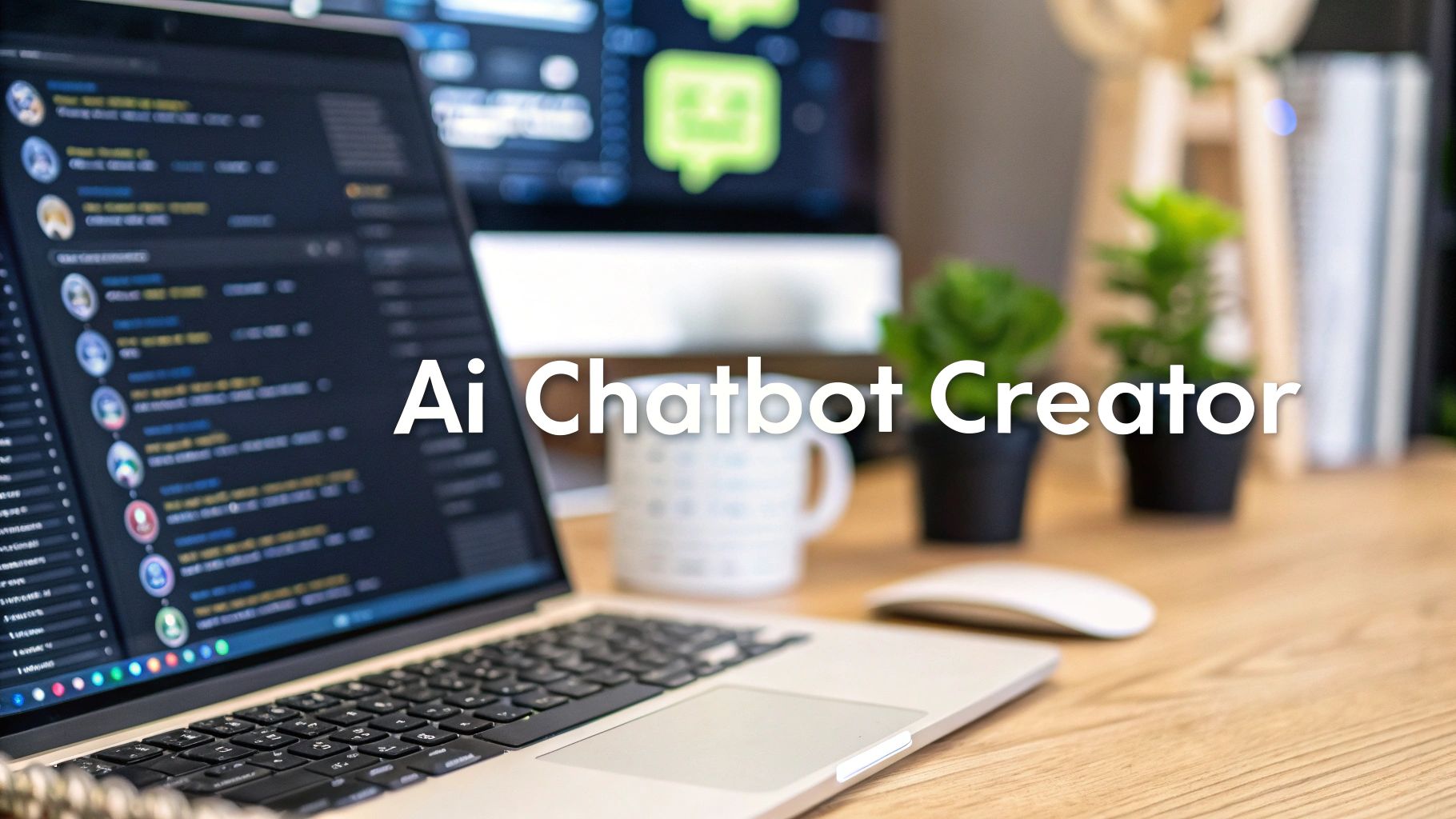The demand for instant, 24/7 customer engagement is no longer a luxury, it's the standard. Businesses, educators, and entrepreneurs are turning to AI chatbot creator tools to automate support, capture leads, and provide personalized experiences without scaling their teams. But with a crowded market ranging from simple no-code builders to powerful developer frameworks, which platform is right for you? This guide cuts through the noise.
We will compare the 12 best AI chatbot creator platforms available today. We'll dive deep into their unique strengths, practical limitations, and ideal use cases to help you choose the perfect tool for your specific goals. For each option, we provide a detailed breakdown covering key features, pricing, and honest pros and cons, complete with screenshots and direct links to get you started faster. Whether you're an e-commerce brand looking to improve post-sale support or a consultant aiming to scale client engagement, this resource is designed to give you clarity.
The applications for these tools extend far beyond typical business functions. For those considering the wider societal impact, exploring how virtual assistants advancing autism support and 508 compliance can highlight incredibly specialized and beneficial use cases. Our analysis will help you select the right AI chatbot creator to build an intelligent, effective, and accessible assistant.
1. ChatbotGen
ChatbotGen distinguishes itself as a premier AI chatbot creator by prioritizing simplicity and speed without sacrificing powerful functionality. It is designed for users who need a sophisticated conversational AI solution but lack the technical expertise or time for complex development cycles. The platform's core strength lies in its "content-first" approach; you can generate a fully functional chatbot in minutes by simply uploading existing documents like FAQs, PDFs, or even just typing in answers to common questions. This fundamentally removes the steep learning curve associated with traditional chatbot builders that require intricate flow-mapping and AI model configuration.
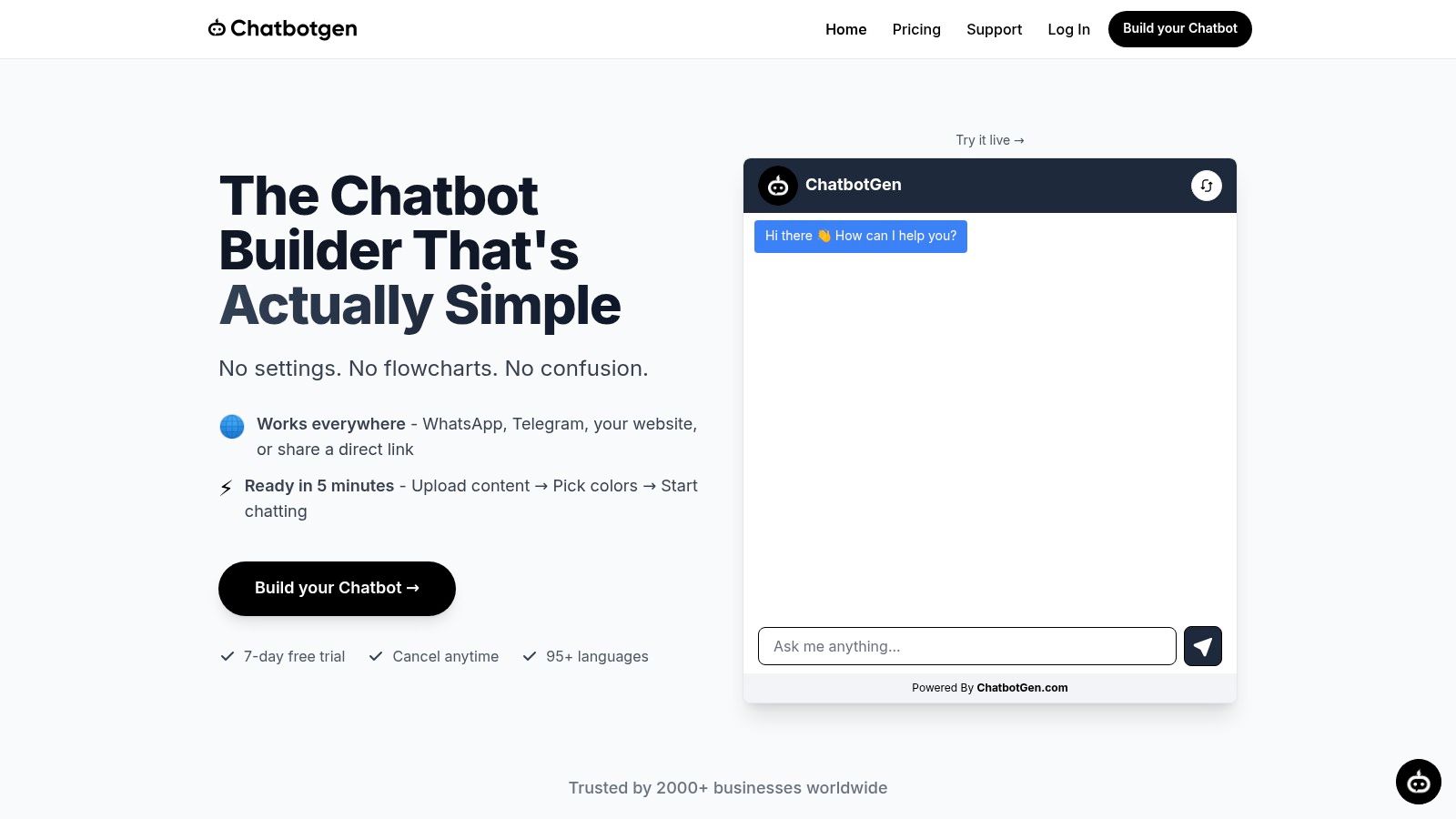
Key Features and Use Cases
The platform excels in practical business applications. For instance, an e-commerce brand can upload its product catalogs and return policy PDFs, and the bot will instantly handle customer queries about specific items or shipping procedures. The visual documentation feature is particularly innovative, allowing the bot to display images directly from uploaded PDFs, which is ideal for real estate agents showcasing properties or educators sharing visual aids from course materials.
- Smart Lead Capture: Integrated forms seamlessly collect user information like names, emails, and service inquiries directly within the chat.
- Multi-channel Deployment: Deploy your chatbot across various platforms, including a direct website widget, WhatsApp Business API, and Telegram.
- Global Reach: With support for over 95 languages, you can cater to an international audience effortlessly.
Practical Implementation
Getting started is exceptionally straightforward. After a quick signup for the 7-day free trial, you upload your content source, customize the chatbot's colors to match your brand, and embed the provided code snippet on your website. No API keys or developer assistance is needed. For those new to the process, ChatbotGen provides clear guidance on how to build a chatbot from scratch on chatbotgen.com.
Why It Stands Out
| Feature | ChatbotGen Advantage | Best For |
|---|---|---|
| Onboarding | Zero learning curve; content-to-chatbot in minutes | Businesses needing rapid deployment |
| User Interaction | Can display images from PDFs for visual context | Real estate, education, e-commerce |
| Data Collection | Smart forms embedded directly in conversations | Lead generation and feedback capture |
| Integrations | Native WhatsApp, Telegram, and WASI CRM | Teams using these core platforms |
Pros:
- Extremely user-friendly no-code interface
- Supports 95+ languages and visual content from PDFs
- Seamless multi-channel deployment options
- Proven to reduce support emails and increase inquiries
Cons:
- Lacks deep AI model customization for advanced developers
- The list of native third-party integrations is still growing
Website: https://chatbotgen.com
2. OpenAI — ChatGPT (custom GPTs and agents)
OpenAI has transformed its popular ChatGPT interface into a powerful ai chatbot creator platform with the introduction of custom GPTs. This feature allows anyone, from solo creators to large enterprises, to build specialized chatbot agents without writing a single line of code. The intuitive, conversational builder guides you through defining the bot's purpose, personality, and knowledge base, making the process incredibly fast from initial idea to a functioning prototype.
The platform stands out for its direct access to OpenAI's latest models and its support for multimodal interactions, including voice and image I/O. For businesses, the Team and Enterprise tiers provide crucial features like dedicated workspaces, single sign-on (SSO), and enhanced security protocols. This makes it a versatile tool for creating internal knowledge bots, customer-facing assistants, or creative brainstorming partners. For a deeper dive into leveraging your own information, explore how to train ChatGPT on custom data.
Key Information
- Best For: Rapid prototyping, internal tools for teams, and individual creators exploring advanced AI capabilities.
- Pricing: A free tier exists with limited access. Paid plans (Plus, Team, Enterprise) are required to build and share custom GPTs, with pricing available at chatgpt.com/pricing.
- Pros: Extremely fast deployment, direct access to cutting-edge models, and a user-friendly builder.
- Cons: Less granular control compared to API-based solutions, and usage caps can be restrictive on lower-tier plans.
3. OpenAI — API Platform (Assistants/Responses APIs)
For developers seeking complete control, OpenAI’s API platform is the ultimate ai chatbot creator toolkit. This approach moves beyond no-code builders, providing the foundational APIs for constructing sophisticated, production-grade chatbot backends. Developers can leverage the latest models, including the GPT-5 lineup, to build highly customized conversational experiences with full-stack control over logic, data handling, and integration.
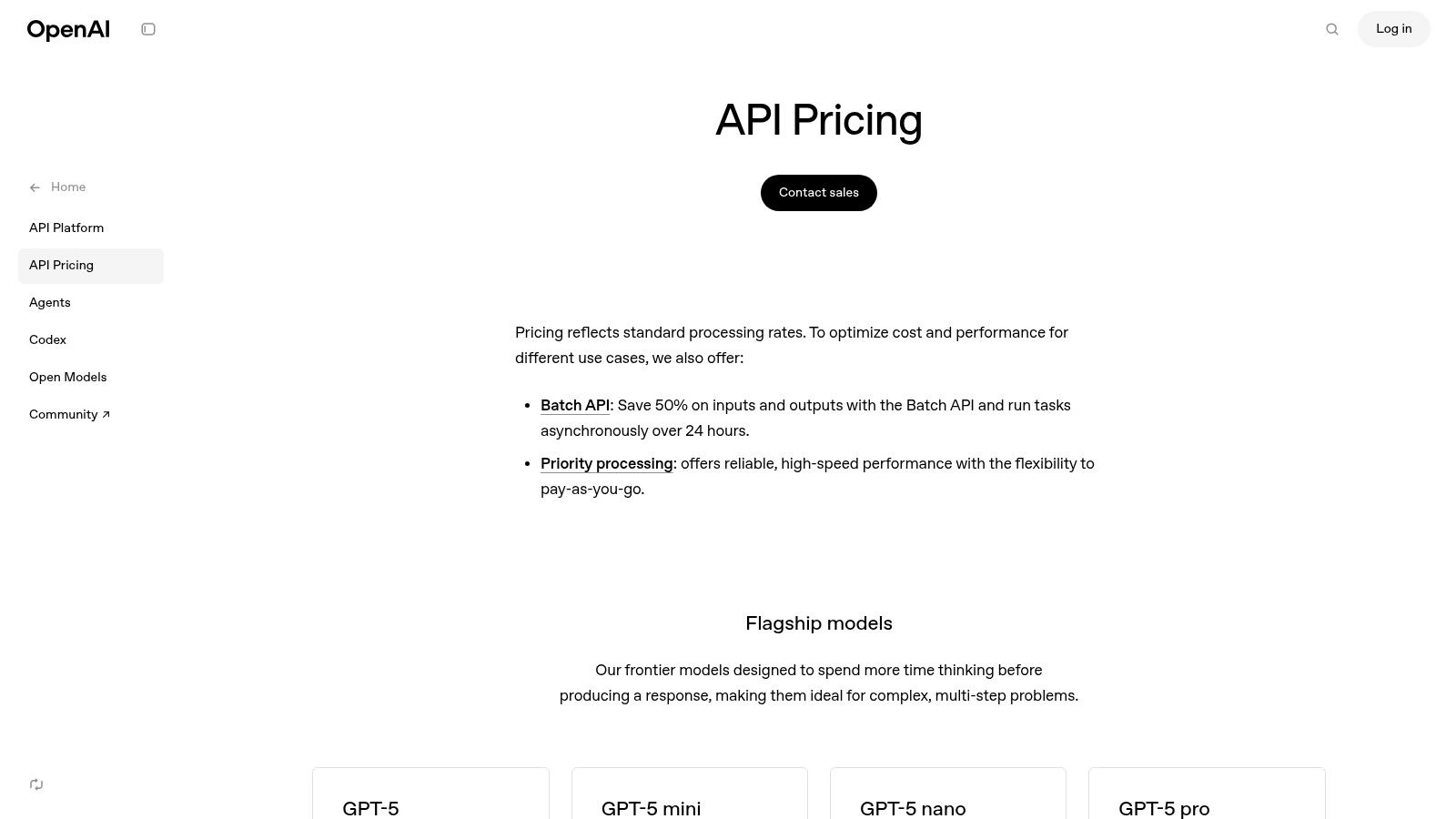
The platform is distinguished by its powerful Assistants and Responses APIs, which streamline complex tasks like tool and function calling, file search, and maintaining conversation history. Features like prompt caching and batch API processing offer significant cost-saving mechanisms for high-volume applications. This granular control makes it ideal for businesses that need to integrate a bespoke chatbot directly into their existing software architecture, ensuring scalability and adherence to specific operational requirements.
Key Information
- Best For: Engineering teams building custom, scalable, and deeply integrated chatbot solutions for production environments.
- Pricing: Pay-as-you-go model based on token usage. Detailed and transparent pricing for various models is available at openai.com/api/pricing.
- Pros: Maximum fine-grained control and scalability, clear per-token pricing with cost-saving features, and a rich toolset (search, images) within a single API.
- Cons: Requires significant engineering effort for hosting and orchestration, and costs can vary widely with traffic, requiring diligent monitoring.
4. Google Cloud — Dialogflow CX (Conversational Agents)
Google Cloud's Dialogflow CX is an advanced, enterprise-grade ai chatbot creator designed for building sophisticated, stateful, multi-turn conversations. It uses a visual state machine approach, allowing developers to map out complex user journeys with clear flows, pages, and routes. This structure is ideal for managing intricate dialogues, such as those required in customer support, transaction processing, and interactive voice response (IVR) systems.
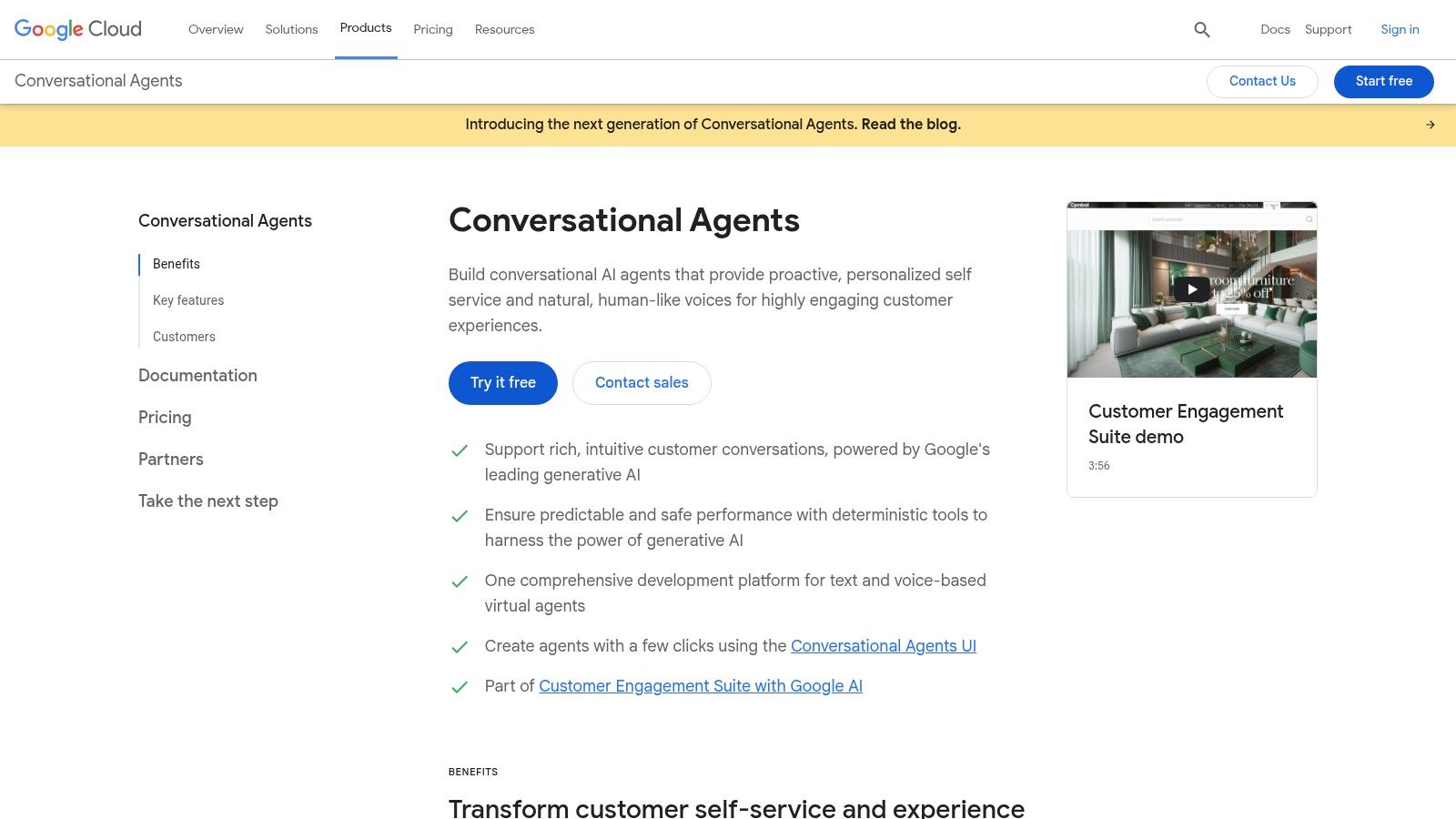
The platform excels at omnichannel deployment, offering seamless integrations for web, mobile, and telephony channels with robust speech-to-text and text-to-speech capabilities. Built on Google's powerful infrastructure, it provides SLA-backed performance and scalability for high-volume operations. While its complexity presents a steeper learning curve than simpler tools, Dialogflow CX is a top-tier choice for organizations needing granular control and reliability for their mission-critical conversational agents.
Key Information
- Best For: Enterprises and large businesses building complex, omnichannel contact center agents and self-service flows.
- Pricing: Follows a pay-as-you-go model based on usage (text or voice sessions). New customers often receive free trial credits. Full pricing details are available at cloud.google.com/dialogflow/pricing.
- Pros: Robust flow management for large-scale bots, powerful speech and multilingual support, and deep integration with the Google Cloud Platform.
- Cons: Pricing can be intricate to estimate due to multiple service components, and it has a higher learning curve than simple no-code tools.
5. Microsoft Azure — Azure AI Bot Service (Bot Framework)
Microsoft Azure provides an enterprise-grade ai chatbot creator platform through its Azure AI Bot Service and Bot Framework. This solution is designed for organizations deeply integrated into the Microsoft ecosystem, offering a robust environment to build, test, deploy, and manage intelligent bots. The service leverages powerful tools like the Bot Framework Composer, a visual designer that simplifies complex conversation flows, and the Bot Framework SDK for developers who need deep customization.
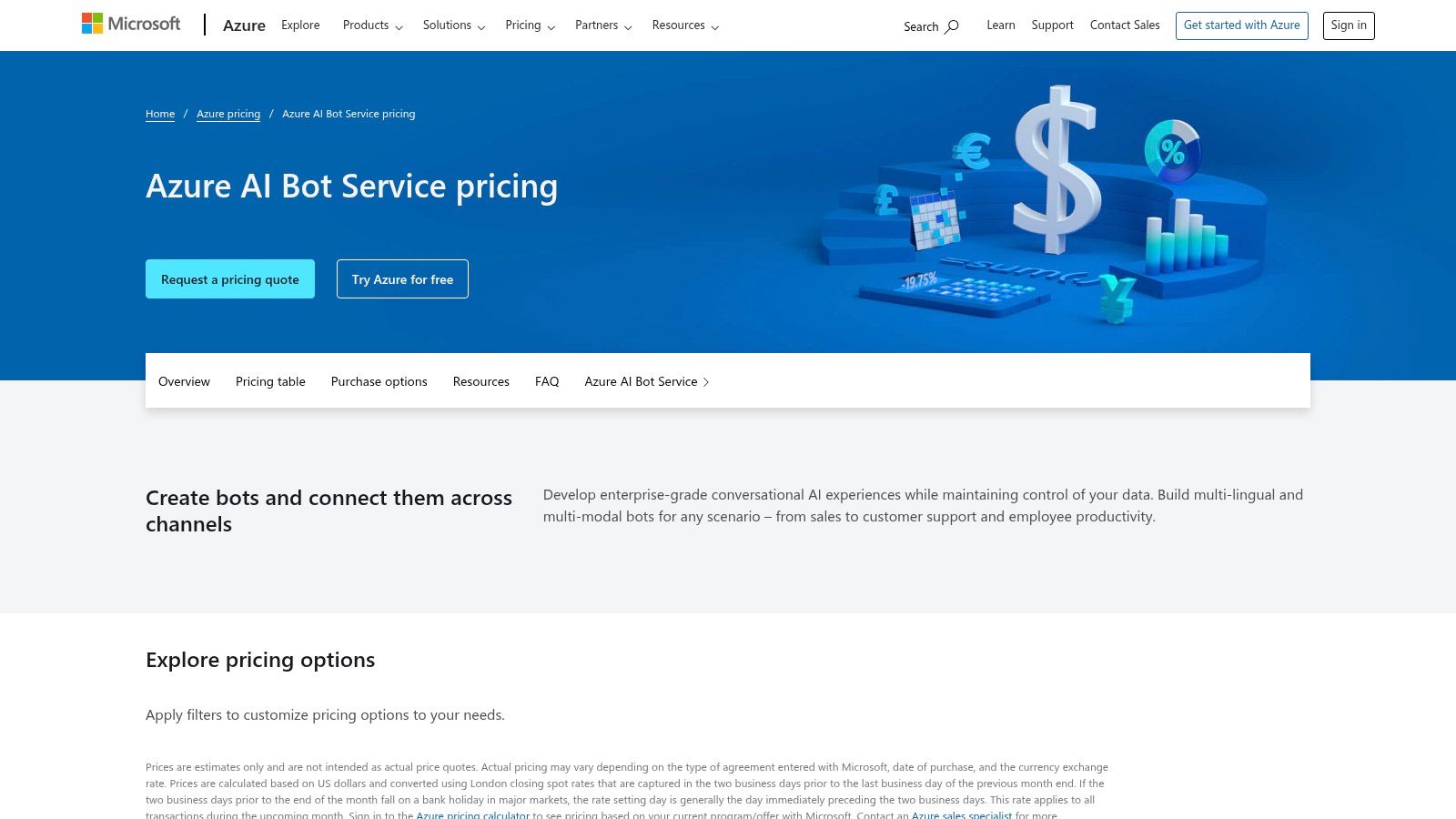
The platform excels at creating bots that connect seamlessly across channels like Microsoft Teams, web chat, and custom applications. Its strength lies in its tight integration with other Azure services for hosting, security, and telemetry, such as Azure App Service and Application Insights. This makes it a formidable choice for businesses needing a chatbot that adheres to familiar operational models, security protocols like Azure AD, and governance standards already in place within their Azure infrastructure.
Key Information
- Best For: Enterprises using the Azure cloud and Microsoft 365, especially for creating internal helpdesk bots or Teams-integrated assistants.
- Pricing: A free tier is available for development. Paid usage is based on a pay-as-you-go model across multiple Azure services (e.g., App Service, Channels), with details at azure.microsoft.com/pricing/details/bot-services.
- Pros: Deep integration with the Microsoft ecosystem, mature developer tools and telemetry, and strong enterprise-level security and governance.
- Cons: The pricing structure can be complex as it spans several services, and it is more developer-centric compared to purely no-code platforms.
6. AWS — Amazon Lex
Amazon Lex brings the powerful conversational AI that drives Alexa into a fully managed service, allowing developers to build sophisticated text and voice chatbots. As an ai chatbot creator integrated deeply within the AWS ecosystem, it excels at creating bots that can be deployed across various channels, including websites, mobile apps, and messaging platforms. The platform uses advanced deep learning functionalities of automatic speech recognition (ASR) for converting speech to text, and natural language understanding (NLU) to recognize the intent of the text.
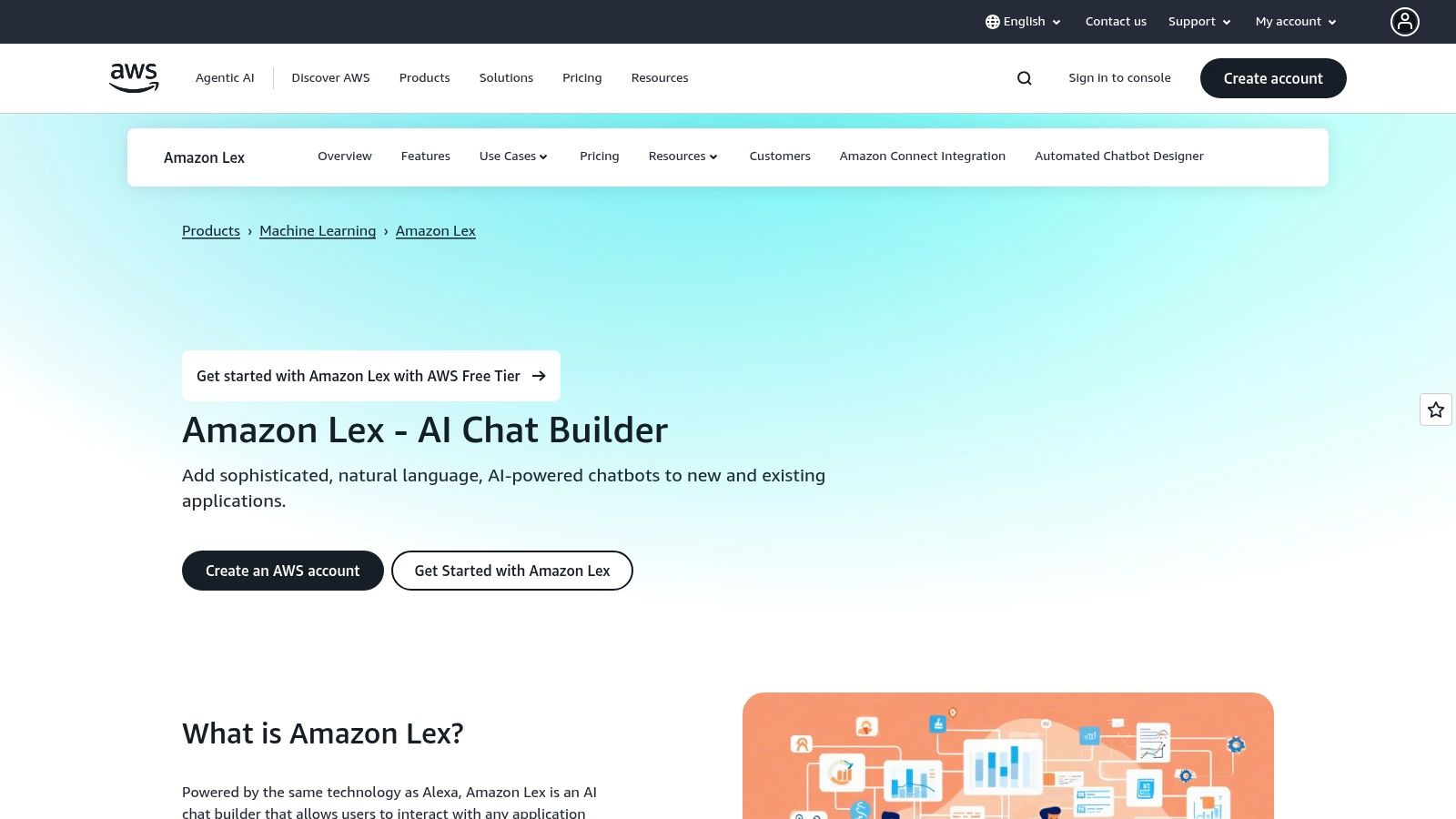
This makes it an ideal choice for businesses already standardized on AWS, offering seamless integrations with services like AWS Lambda for business logic and Amazon Connect for building AI-powered contact centers. Lex provides an automated chatbot designer that can build a bot from conversation transcripts, significantly accelerating development. Its production-ready voice capabilities are a key differentiator, enabling rich, voice-first user experiences for a wide range of applications from customer service to in-app assistants.
Key Information
- Best For: Developers and businesses standardized on AWS seeking scalable, production-grade voice and text bots.
- Pricing: Pay-as-you-go pricing with a generous free tier for the first year. Pricing is available at aws.amazon.com/lex/pricing.
- Pros: Strong integration with the AWS ecosystem, robust and production-ready voice bot capabilities, and a scalable, usage-based pricing model.
- Cons: The flow-building interface can feel less visual and intuitive than some dedicated CX platforms, and the pricing structure can be complex to calculate.
7. IBM — watsonx Assistant
IBM’s watsonx Assistant is an enterprise-grade ai chatbot creator designed for organizations where data security, governance, and omnichannel deployment are paramount. It empowers businesses to build sophisticated virtual agents that can be deployed across web chat, phone systems (voice/IVR), and SMS channels. The platform is particularly well-suited for regulated industries like finance and healthcare, offering robust data isolation and compliance features that ensure sensitive information is handled securely.
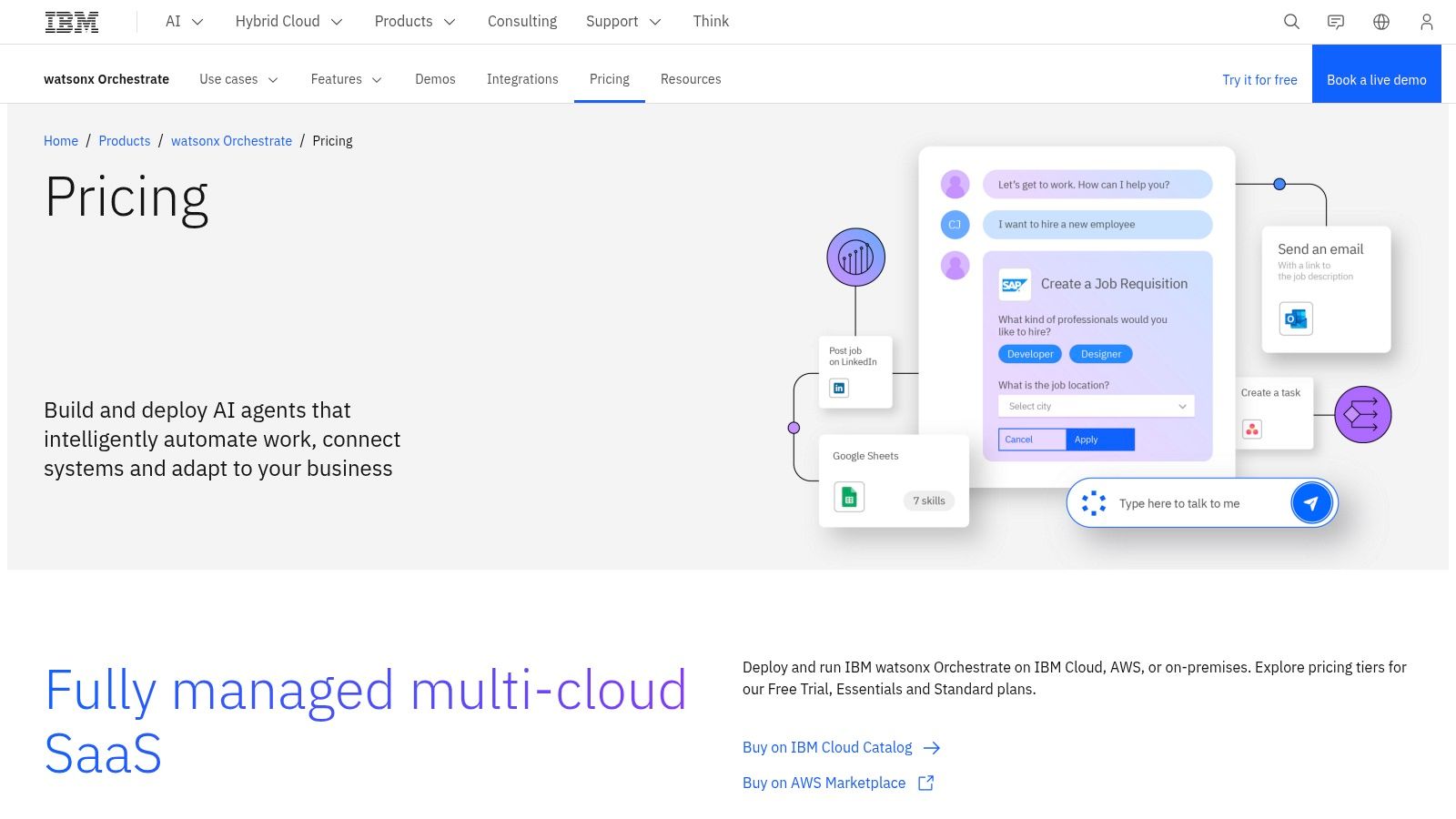
Unlike many lighter tools, watsonx Assistant provides deep, built-in analytics and auto-learning capabilities to continuously optimize bot performance based on real user interactions. It integrates generative AI features using IBM's proprietary Granite models for more natural, conversational answers sourced from your own knowledge base. While it can be a heavyweight platform for simple use cases, its power lies in creating scalable, secure, and intelligent assistants that manage complex customer service and internal support functions effectively.
Key Information
- Best For: Large enterprises, regulated industries, and businesses needing robust omnichannel (voice/SMS) support and advanced analytics.
- Pricing: Offers a free Lite plan. Paid plans are based on monthly active users (MAU), starting at $140/month. Details are available at ibm.com/products/watsonx-assistant/pricing.
- Pros: Strong enterprise security and compliance, clear MAU-based pricing, and comprehensive analytics for bot optimization.
- Cons: Overkill for many small businesses, and some generative AI features may require metered add-ons.
8. Rasa (open source + commercial)
Rasa is a leading open-source framework that positions itself as a pro-code ai chatbot creator for organizations that require complete control and deep customization. Unlike no-code platforms, Rasa gives engineering teams the tools to build, deploy, and orchestrate sophisticated conversational AI on their own infrastructure, whether on-premises or in a private cloud. This approach is ideal for enterprises in regulated industries or those with strict data privacy and security requirements who cannot use third-party cloud services.
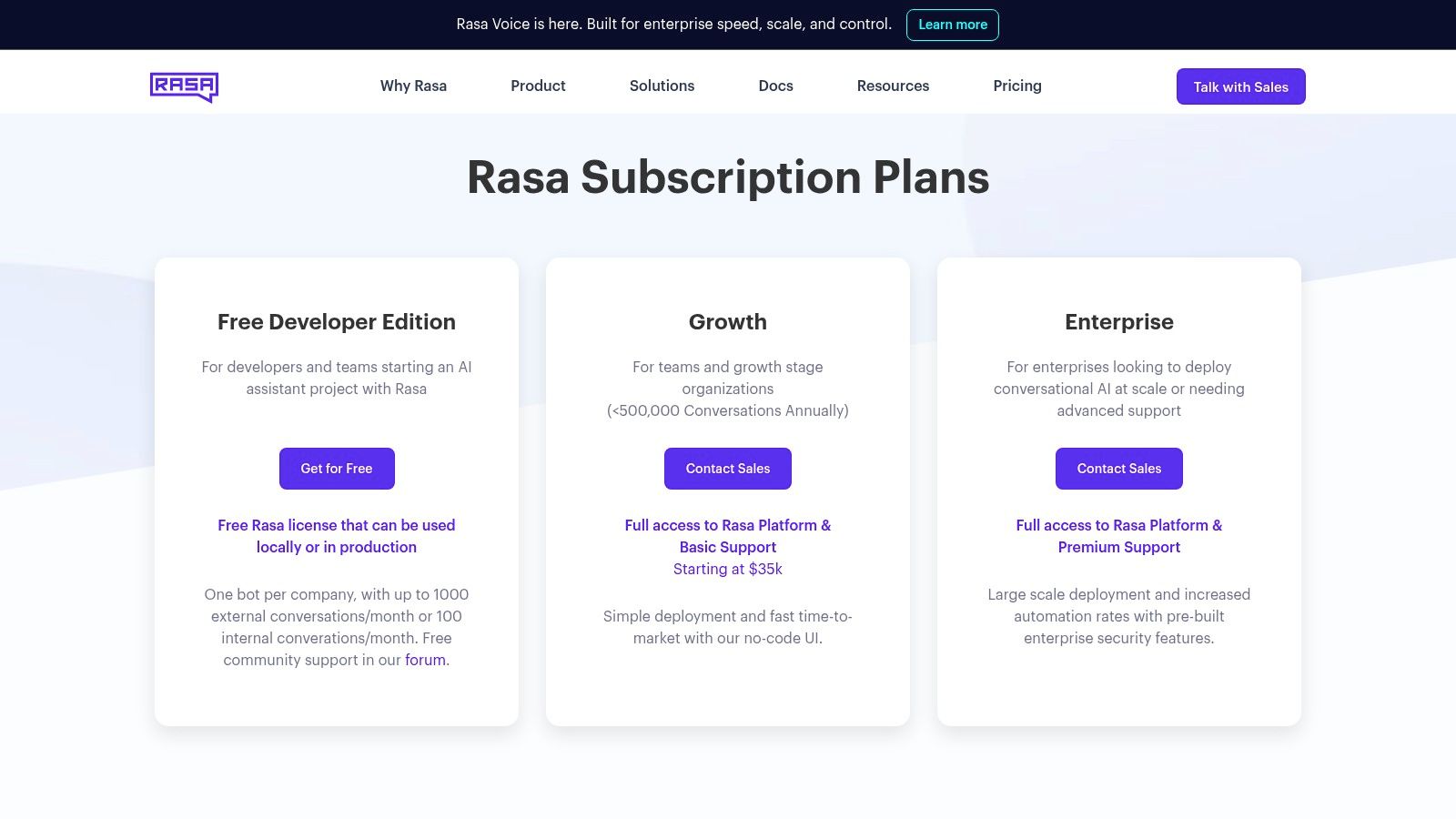
The platform excels at complex dialogue management and LLM orchestration, allowing developers to fine-tune conversation policies and integrate multiple systems. While the open-source version provides the core engine, the commercial Rasa Platform adds enterprise-grade features like advanced analytics, voice and telephony integrations, and dedicated support tiers. This dual offering makes Rasa a powerful choice for businesses that want to start with a flexible open-source foundation and scale to a fully supported, mission-critical solution without vendor lock-in.
Key Information
- Best For: Engineering-led teams in large enterprises that need maximum customization, data control, and on-premise deployment.
- Pricing: Rasa Open Source is free. Commercial plans (Rasa Pro) for the enterprise platform are priced with a high annual spend, available at rasa.com/product/pricing.
- Pros: Unparalleled customization and control, strong open-source community, and robust enterprise security features in paid tiers.
- Cons: Requires significant engineering resources to implement and maintain, and commercial plans have a high cost of entry.
9. Botpress (hosted studio for AI agents)
Botpress offers a powerful visual studio that bridges the gap between no-code simplicity and developer-grade control, positioning it as a versatile ai chatbot creator. It empowers users to build sophisticated GPT-powered agents through a drag-and-drop interface, complete with a live emulator for instant testing and shareable links for stakeholder feedback. The platform excels at ingesting complex information, allowing you to index knowledge from websites, documents, and tables into a vector database for accurate, context-aware responses.
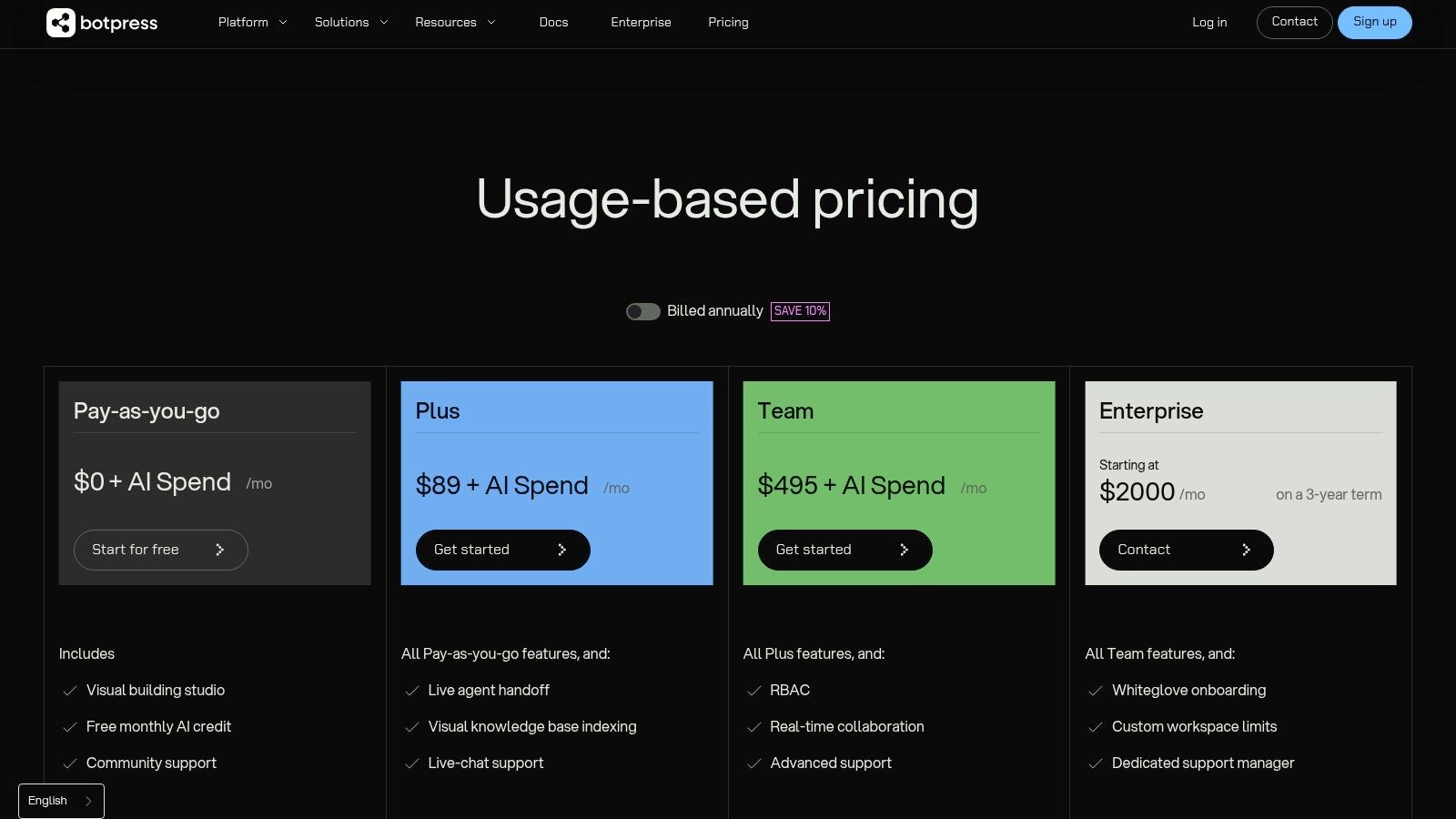
This makes Botpress ideal for small to medium-sized businesses and agencies that need a scalable solution without a massive upfront investment. Features like native live agent handoff and a customizable web chat widget provide a complete toolkit for customer-facing applications. The pay-as-you-go model is particularly attractive, as it ensures you only pay for what you use without any markup on the underlying LLM provider costs, offering transparent and predictable pricing.
Key Information
- Best For: SMBs and agencies needing a balance of visual building, scalability, and transparent pricing.
- Pricing: A generous free tier is available. Paid plans are pay-as-you-go with tiered subscriptions for additional features, detailed at botpress.com/pricing.
- Pros: Low startup cost with included AI credits, no markup on LLM usage, and a powerful visual builder.
- Cons: Advanced features require higher-tier plans, and costs are dependent on variable third-party LLM pricing.
10. Intercom (Fin AI Agent + help desk)
Intercom integrates its sophisticated Fin AI Agent directly into a mature customer support platform, offering a powerful, all-in-one solution. This platform is more than just an ai chatbot creator; it's a complete help desk that uses AI to resolve customer issues instantly. Fin, the AI agent, is designed to understand complex queries, provide accurate answers from your knowledge base, and only escalate to human agents when truly necessary, streamlining support operations significantly.
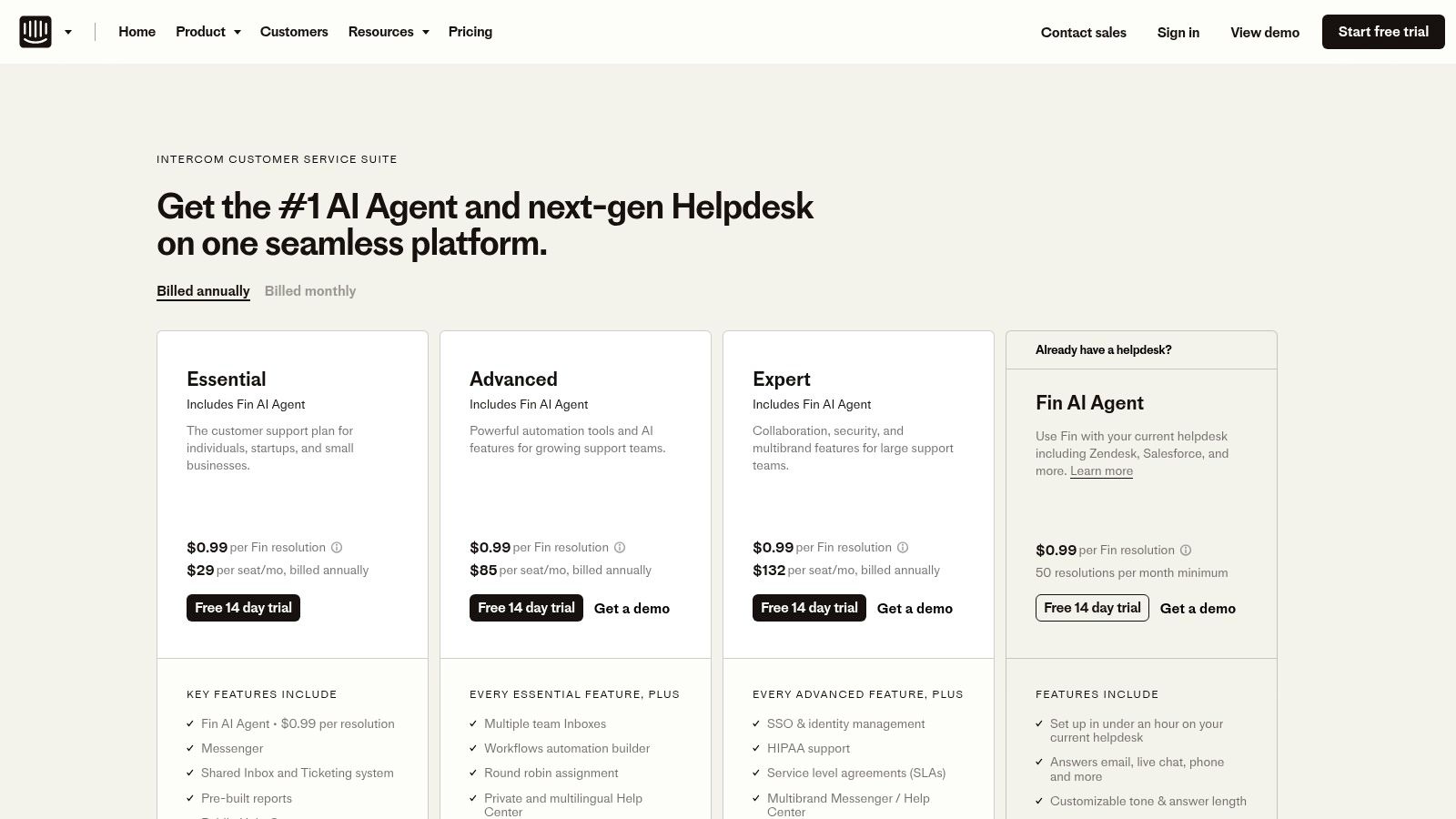
The platform excels by combining AI automation with robust tools like a shared inbox, ticketing, and proactive messaging. Its visual workflow builder allows for creating custom automation rules without code, while its multilingual help center and detailed analytics provide the insights needed to scale support globally. This integrated approach makes it an excellent choice for businesses aiming to deliver a seamless, AI-first customer service experience through its well-regarded Messenger and in-app chat.
Key Information
- Best For: Startups to enterprises wanting an integrated AI-first helpdesk and chatbot solution.
- Pricing: Custom pricing based on agent seats and AI resolutions. Plans and details are available at www.intercom.com/pricing.
- Pros: Simple per-resolution AI pricing, mature support tooling and reporting, and strong Messenger and in-app chat experiences.
- Cons: Costs can accumulate with combined agent seats and high AI usage; less developer-centric compared to frameworks like Rasa.
11. Voiceflow (design, test, and deploy chat/voice agents)
Voiceflow has established itself as a leading collaborative platform for product teams looking to design, test, and deploy sophisticated chat and voice agents. Positioned as a powerful ai chatbot creator, it excels in moving projects from early prototypes to full-scale production. Its visual, drag-and-drop builder, combined with an Agent CMS and knowledge base integrations, provides a robust environment for building complex conversational flows without deep coding expertise. This makes it an ideal tool for teams focused on delivering high-quality customer experiences.
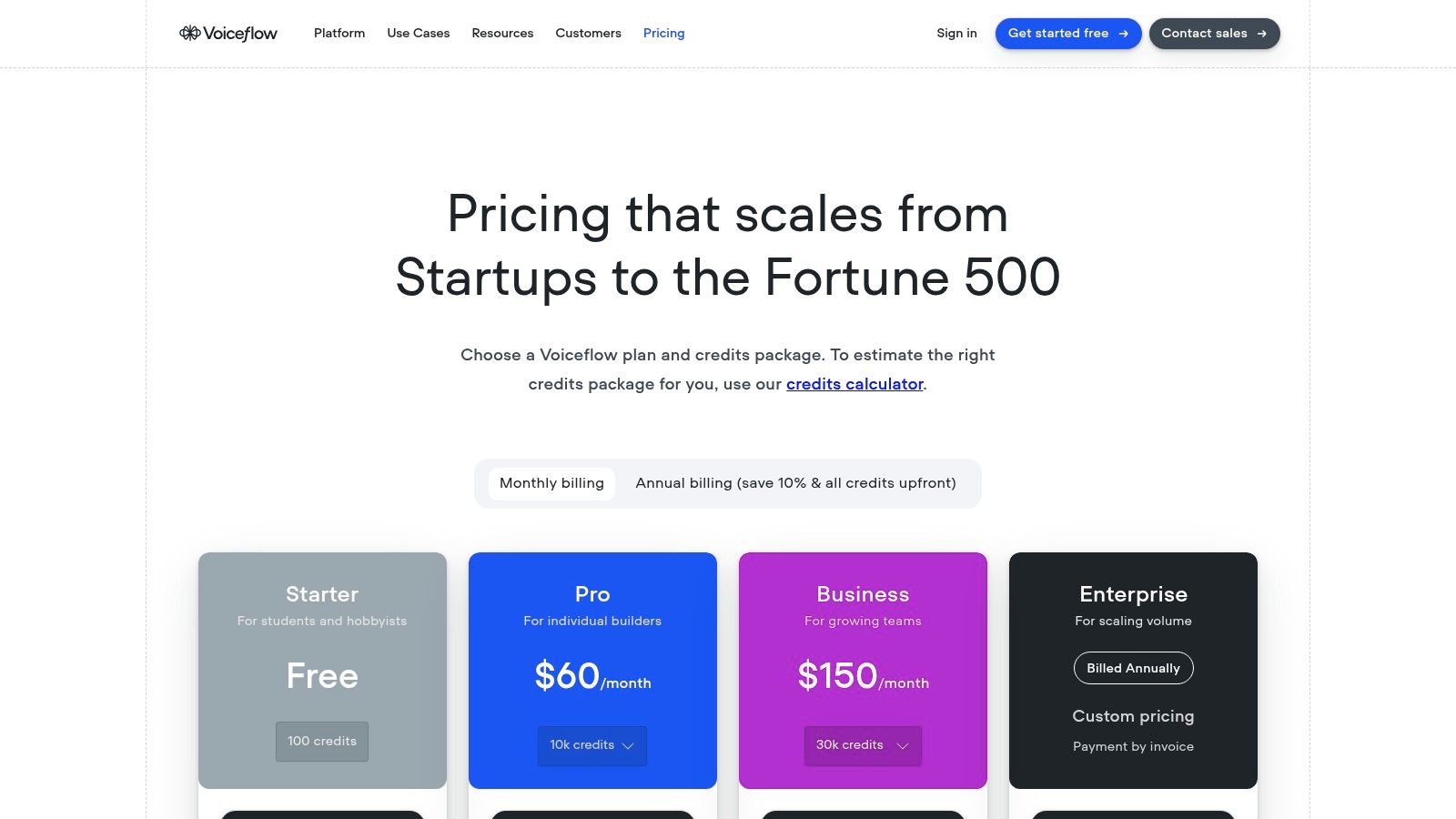
The platform stands out by supporting multiple large language models (LLMs) and allowing creators to set up fallback strategies, ensuring agent reliability. For deployment, Voiceflow offers embeddable web widgets and supports concurrent voice calls, catering to a wide range of use cases. These features are particularly valuable for industries requiring instant, accurate responses, and you can explore an example with our guide to building a real estate chatbot. Higher-tier plans add crucial enterprise features like team collaboration, versioning, and SSO for enhanced security and workflow management.
Key Information
- Best For: Product teams, UX/UI designers, and developers building and testing complex conversational experiences for chat and voice.
- Pricing: A free tier is available for individuals. Paid plans (Pro, Enterprise) are required for team collaboration and advanced features, with pricing available at www.voiceflow.com/pricing.
- Pros: Excellent for rapid prototyping and usability testing, clear credit system for usage, and strong documentation with templates.
- Cons: Credits must be carefully managed for higher traffic volumes, and some advanced use cases may require external hosting.
12. Landbot (no-code web/WhatsApp chatbot builder)
Landbot excels as a no-code ai chatbot creator designed for building conversational experiences across websites, WhatsApp, and Messenger. Its intuitive drag-and-drop flow builder allows users to visually map out complex customer journeys, integrating conditional logic, media, and user inputs without any coding. This makes it a go-to platform for SMBs and marketing agencies aiming to automate lead generation, qualify prospects, and deflect common support queries with interactive, engaging bots.
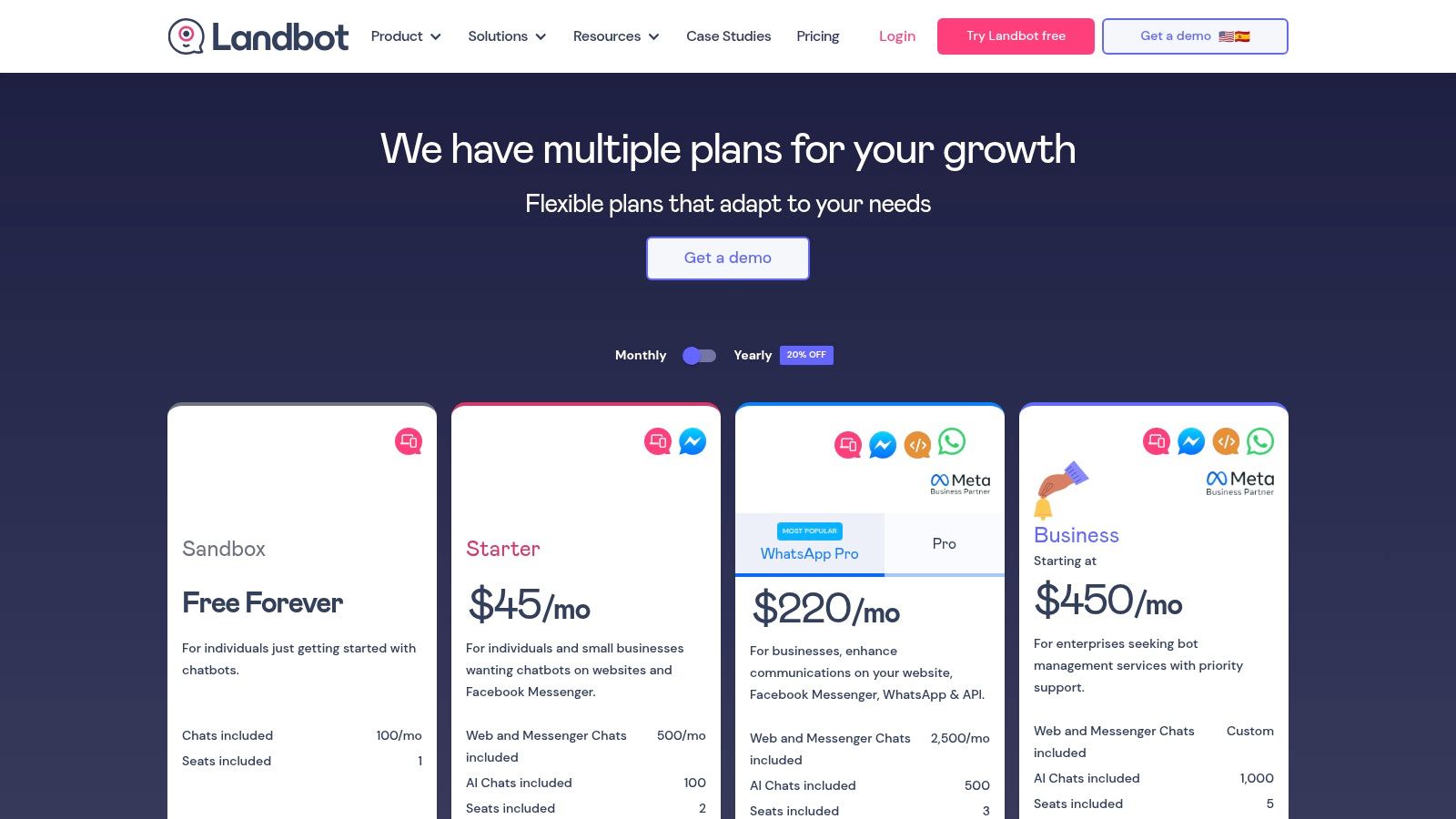
The platform stands out with its strong focus on WhatsApp, offering managed packages that simplify the otherwise complex setup process. Key features include seamless human-to-bot handoffs to a team inbox, native integrations with tools like HubSpot and Stripe, and the ability to connect to any service via webhooks. While its core strength is rule-based flows, it also integrates AI capabilities for more natural language understanding, offering a balanced approach to automation.
Key Information
- Best For: Marketing agencies, SMBs, and e-commerce stores focused on lead capture and customer engagement on web and WhatsApp.
- Pricing: Offers a free plan with limited chats. Paid plans scale by features, seats, and chat volume, with details at landbot.io/pricing.
- Pros: Highly visual and intuitive flow builder, excellent support for WhatsApp, and clear pricing tiers for easy scaling.
- Cons: Advanced AI features are less prominent than in AI-first platforms, and overage charges for extra chats can accumulate quickly.
Top 12 AI Chatbot Creator Comparison
| Product | Core Features/Characteristics | User Experience & Quality ★ | Value Proposition 💰 | Target Audience 👥 | Unique Selling Points ✨ |
|---|---|---|---|---|---|
| 🏆 ChatbotGen | No-code, upload content, 95+ languages, smart forms | ★★★★☆ Easy, zero learning curve | 💰 Simple pricing with 7-day free trial | 👥 SMBs, educators, real estate, ecommerce, solo entrepreneurs | ✨ Visual docs with images, multi-channel deploy, proven results |
| OpenAI — ChatGPT (custom GPTs & agents) | Custom GPT builder, voice/video input, team workspaces | ★★★★☆ Fast deployment, broad ecosystem | 💰 Usage caps; API billed separately | 👥 Solo creators to enterprises | ✨ Advanced multimodal, evolving GPT models |
| OpenAI — API Platform | APIs for GPT-5, tool/function calling, prompt caching | ★★★★☆ Fine-grained control but engineering needed | 💰 Token-based pricing, batch discounts | 👥 Developers, enterprises | ✨ Full-stack control, cost-saving tooling |
| Google Cloud — Dialogflow CX | Visual flow builder, telephony, SLA scaling | ★★★★ Robust bot flow, multilingual & speech support | 💰 Complex pricing; free trial credit | 👥 Enterprises, contact centers | ✨ Visual CX design, telephony integration |
| Microsoft Azure — Azure AI Bot Service | Bot Framework SDK, multi-channel, Azure hosting | ★★★★ Mature tooling, telemetry, MS365 integration | 💰 Multiple service pricing | 👥 Enterprises on Azure & MS365 | ✨ Deep MS ecosystem integration, strong security |
| AWS — Amazon Lex | Text & speech bots, AWS ecosystem integration | ★★★★ Production-ready voice, streaming support | 💰 Usage-based pricing, free tier | 👥 AWS-centric developers | ✨ Alexa ASR/NLU tech, contact center integration |
| IBM — watsonx Assistant | Voice/SMS, enterprise security, analytics | ★★★★ Strong compliance & governance | 💰 MAU-based pricing | 👥 Regulated industries, large enterprises | ✨ Advanced analytics, generative answers |
| Rasa (open source + commercial) | Pro-code, on-prem/private cloud, orchestration | ★★★★ Maximum customization, strong open source | 💰 High-cost commercial tiers | 👥 Engineering-led orgs | ✨ Full control, private deployment |
| Botpress (hosted studio) | Visual AI studio, knowledge indexing, live handoff | ★★★★ Low startup cost, pay-as-you-go pricing | 💰 Clear limits, no LLM markup | 👥 SMBs, agencies | ✨ Shareable prototypes, pay provider LLM cost |
| Intercom (Fin AI Agent + help desk) | AI agent, ticketing, multilingual help center | ★★★★ Mature support & reporting | 💰 Per-resolution AI pricing | 👥 Startups to enterprises | ✨ Integrated AI helpdesk, workflow automation |
| Voiceflow (chat/voice agents) | Visual builder, multi-LLM, team collaboration | ★★★★ Great for prototyping & testing | 💰 Credit system, external hosting | 👥 Product teams, CX designers | ✨ Multi-LLM fallback, embeddable widgets |
| Landbot (no-code web/WhatsApp builder) | Drag-and-drop builder, WhatsApp/Messenger support | ★★★★ Quick SMB setup, clear allowances | 💰 Add-on fees for extra chats/messages | 👥 SMBs, agencies | ✨ WhatsApp packages, live chat handoff |
Choosing the Right AI Chatbot Creator For Your Needs
The journey to finding the perfect ai chatbot creator can seem complex, but as we've explored, the landscape is rich with options tailored to virtually every need. From powerful, developer-centric frameworks like Microsoft's Azure AI Bot Service and the open-source flexibility of Rasa, to enterprise-grade conversational AI platforms like Google's Dialogflow CX and IBM's watsonx Assistant, the power to build sophisticated AI is more accessible than ever. The key takeaway is that the "best" tool is not a one-size-fits-all answer; it's the one that aligns perfectly with your unique resources, goals, and technical comfort level.
Key Factors in Your Decision
Before you make a final choice, distill your requirements down to a few core priorities. A clear understanding of your non-negotiables will instantly narrow the field and point you toward the right solution.
- Technical Expertise: Are you a non-technical business owner, a marketing professional, or a seasoned developer? No-code platforms like Landbot and ChatbotGen are built for speed and simplicity, while API-first solutions from OpenAI and AWS demand programming skills but offer near-limitless customization.
- Primary Use Case: Your goal dictates the necessary features. For advanced customer service automation integrated into a help desk, Intercom's Fin AI is a strong contender. For designing intricate, multi-turn conversational flows for both voice and chat, Voiceflow provides a specialized visual canvas.
- Time to Deployment: How quickly do you need to see results? If your objective is to launch a functional, knowledge-based chatbot this week, a tool that builds from existing content is essential. Platforms requiring extensive training data, flow-charting, and development will naturally have a longer implementation cycle.
- Scalability and Control: Consider your future needs. While a simple tool might solve today's problem, will it grow with you? An open-source framework like Rasa offers maximum long-term control, whereas a user-friendly platform like Botpress provides a managed environment that balances ease of use with powerful agent-building capabilities.
Your Path Forward: From Evaluation to Implementation
Selecting an ai chatbot creator is the first step in a larger automation strategy. The real value is unlocked during implementation and continuous improvement. As you move forward, focus on defining a clear scope for your bot's responsibilities, preparing high-quality knowledge sources, and establishing metrics to measure its success. Remember, the goal isn't just to deploy a chatbot; it's to create an intelligent assistant that genuinely enhances user experience, saves your team valuable time, and contributes directly to your business objectives. The right platform will feel less like a complex piece of software and more like a strategic partner in achieving that vision.
Ready to bypass the steep learning curve and launch a powerful AI assistant in minutes? ChatbotGen is the ideal ai chatbot creator for businesses and creators who prioritize speed and efficiency. Train a custom chatbot on your documents, website content, or even YouTube videos, and embed it anywhere without writing a single line of code.
Start building your intelligent chatbot for free with ChatbotGen.
